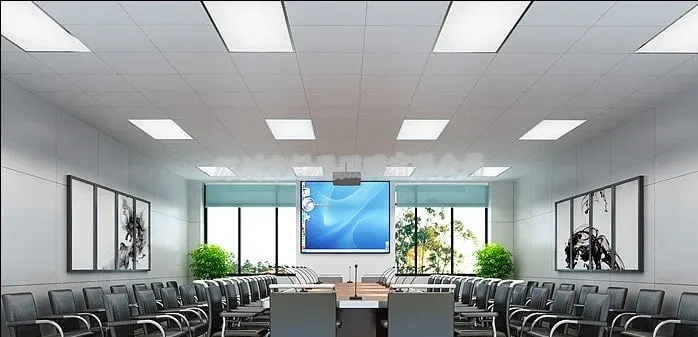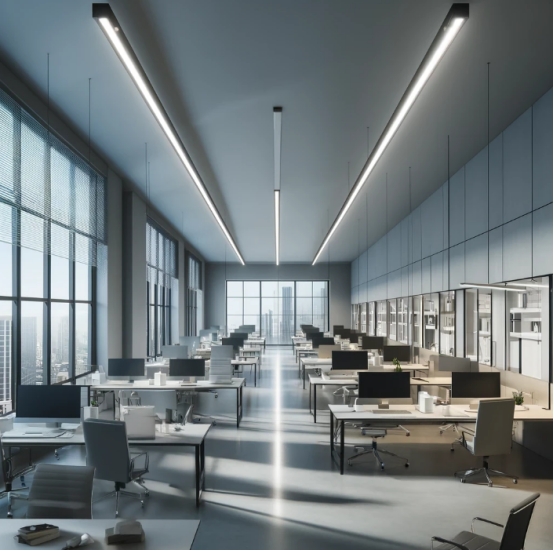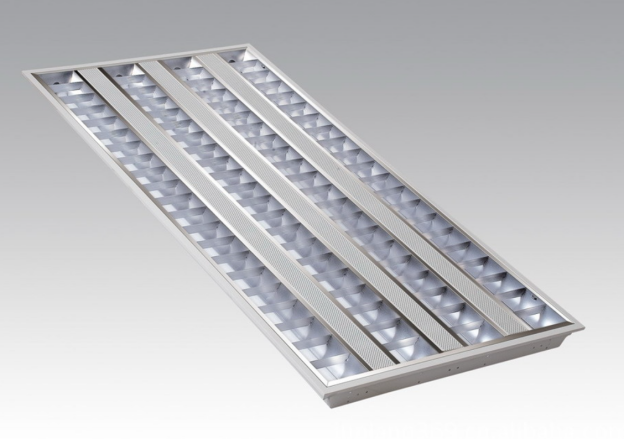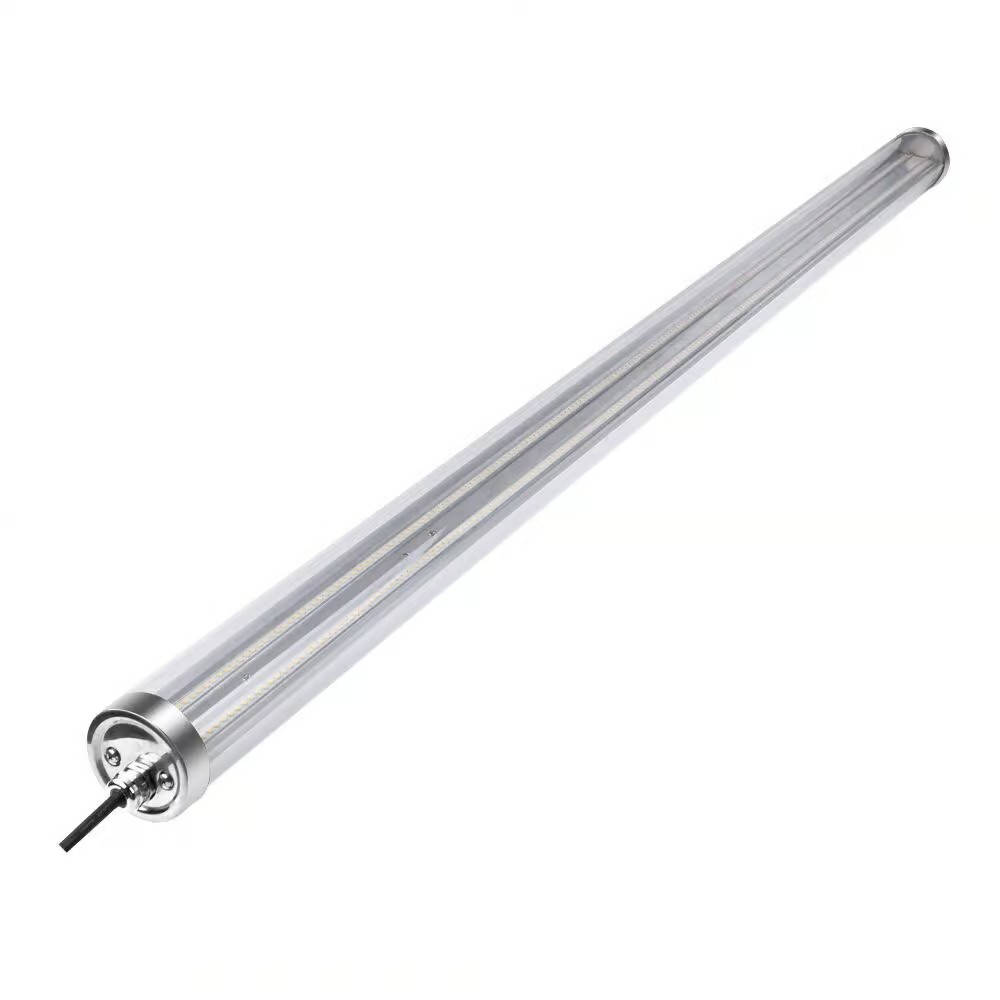
If you run a factory or a warehouse, you know how important it is to have proper lighting.
Lighting affects not only the workers’ productivity and safety but also the operations’ quality and efficiency. Poor lighting can lead to errors, accidents, eye strain, fatigue, and health problems.
But how do you choose the best lighting for your factory or warehouse?
There are many factors to ponder, such as the size and layout of your space, the type and quantity of products you store or produce, the level and color of illumination you need, the energy consumption and maintenance costs of the lighting system, and the environmental impact of your lighting choices.
LED tubular lights are among the best lighting options for factories and warehouses due to their brightness, energy efficiency, durability, and versatility. They can light up large areas, minimize glare and shadows, and withstand harsh environmental conditions.
However, finding a reliable lighting manufacturer that can offer high-quality LED tubular lights to fit the application’s needs and preferences is essential. That’s why you should prefer Olamled.
Olamled is a leading manufacturer and supplier of lighting products for residential, industrial, and commercial settings, with over 14 years of experience. Their products meet the highest international quality and safety standards, including CE, RoHS, and FCC.
OlamLED produces a wide range of lighting and fixtures, including tubular light bulbs as well as customized lighting products for your specific application.
Continue reading to learn how tubular LED bulbs can transform factory or warehouse lighting.
What are Tubular Light Bulbs?
Tubular light bulbs, also known as tube lights or linear light bulbs, are electric light bulbs with a long, cylindrical shape with a tubular glass envelope.
They are known for their efficiency and high-light output, making them a standard lighting option for floodlighting, commercial, residential, and industrial purposes, including factories and warehouses.
What are their characteristics?
Various features and characteristics contribute to making tubular lights the most suitable option for large and industrial spaces:
- Wattage: The wattage of tubular light bulbs varies depending on the type and size of the bulb. Generally, LED and fluorescent tubular bulbs use less energy than incandescent bulbs.
- Color Temperature: These lights come in different color temperatures, measured in Kelvins (K). Lower Kelvin values (2700K-3000K) produce a warm, yellow light similar to incandescent bulbs, while higher Kelvin values (4000K-6500K) produce a cooler, bluish-white light.
- Light’s Size: Tubular lights come in various sizes, from small to large. The most common sizes are T8 and T12, which refer to the bulb’s diameter in eighths of an inch.
- Applications: Tubular light bulbs are commonly used for industrial and commercial settings such as retail stores, offices, and warehouses. Besides, they can be used as task lighting and under cabinet lighting.
- Versatility in fitting: Tubular LED bulbs can produce bright, uniform light covering a wide area. They can be installed in rows or clusters to form different lighting patterns and effects. Moreover, they can be mounted on ceilings, walls, or fixtures to suit different layouts and heights.
- Light’s Shape: As the name implies, tubular light bulbs have a tubular shape, which makes their light more focused and directional than traditional bulb shapes.
- Features: The tubular light bulbs can be dimmable or non-dimmable to adjust the light level according to the needs and preferences. Besides, they are available in different color options and remote-controlled features.
Types of Tubular Light Bulbs:
1. Incandescent tubular light bulbs:
Incandescent bulbs are the traditional light sources that glow when electricity flows through a thin wire called a filament. They are easy on the wallet and widely available but they have many disadvantages.
Incandescent bulbs waste a lot of energy and heat up quickly. They burn out fast, lasting only about 1,000 hours. Moreover, they produce a warm and yellowish light that may not fit some needs and preferences.
Besides, incandescent bulbs are delicate and can break easily.
2. Fluorescent tubular light bulbs
Fluorescent bulbs are the popular light sources that shine when electricity passes through a gas-filled tube that produces UV (ultraviolet) light. The UV light then hits a phosphor coating on the tube’s inside, turning it into visible light.
Tubular fluorescent bulbs last longer and use less energy than incandescent bulbs, but they also have some drawbacks.
They contain mercury and other harmful materials that can contaminate the environment if broken, so requires special handling and disposal. Besides, prolonged and continuous exposure to UV light emitted from this bulb can cause serious health problems in workers.
These bulbs are also energy-inefficient and produce a cool, bluish omnidirectional light that may not suit some industrial applications. Besides, their light consistently flickers and hums when they are turned on. And this flickering further increases when they get old, which can be irritating and disturbing.
Tubular fluorescent bulbs are also affected by frequent turning on and off, as well as variations in temperature and humidity levels, which may reduce their performance and lifespan.
Moreover, the fixtures for these bulbs require additional maintenance, such as, more often replacement of ballast.
3. LED tubular light bulbs
They are the latest and most advanced type of tubular light bulb, passing an electric current through a semiconductor material that emits light like a regular LED bulb.
Tubular LED lights are available in 3 main types: plug-and-play bulbs (Type A), Hybrid, and Universal LED tubes.
These lights are the best option for factories, warehouses, garages, storage areas, and fabrication centers because they have many benefits over other tubular light bulbs.
- LED tubular lights provide better light quality and performance than their counterparts. They deliver bright, uniform light with improved color rendering. They also reduce glare and shadows, enhancing visibility and comfort and enabling workers to see things as in natural light.
- LED tubular light bulbs are energy-efficient, produce less heat, and use significantly less energy than fluorescent and halogen bulbs. Besides, they can save up to 80% of electricity compared to an incandescent light bulb, making them more economical, eco-friendly, and ideal for reducing electricity bills and carbon footprints.
- LED tubular light bulbs require low maintenance and last longer than other bulbs. They can last more than 50,000 hours, decreasing the chances for frequent replacements.
- LED tubular bulbs are more durable than fluorescent and halogen bulbs. They are shatterproof and less prone to damage from vibration and shock. They are also resistant to dust, moisture, extreme temperatures, chemicals, and acidic environment, making them ideal for use in commercial and industrial settings with harsh climates.
- LED tubes light up instantly and need NO warm-up time. This makes them suitable for use in areas where instant lighting is required, such as parking lots and warehouses.
- LED tubular light bulbs emit bright and natural light that can be customized in color and intensity. They are available in various color temperatures, from warm yellow to cool white. This allows you to select the most suitable color temperature for specific lighting needs.
Benefits of LED Tubular Light Fixtures
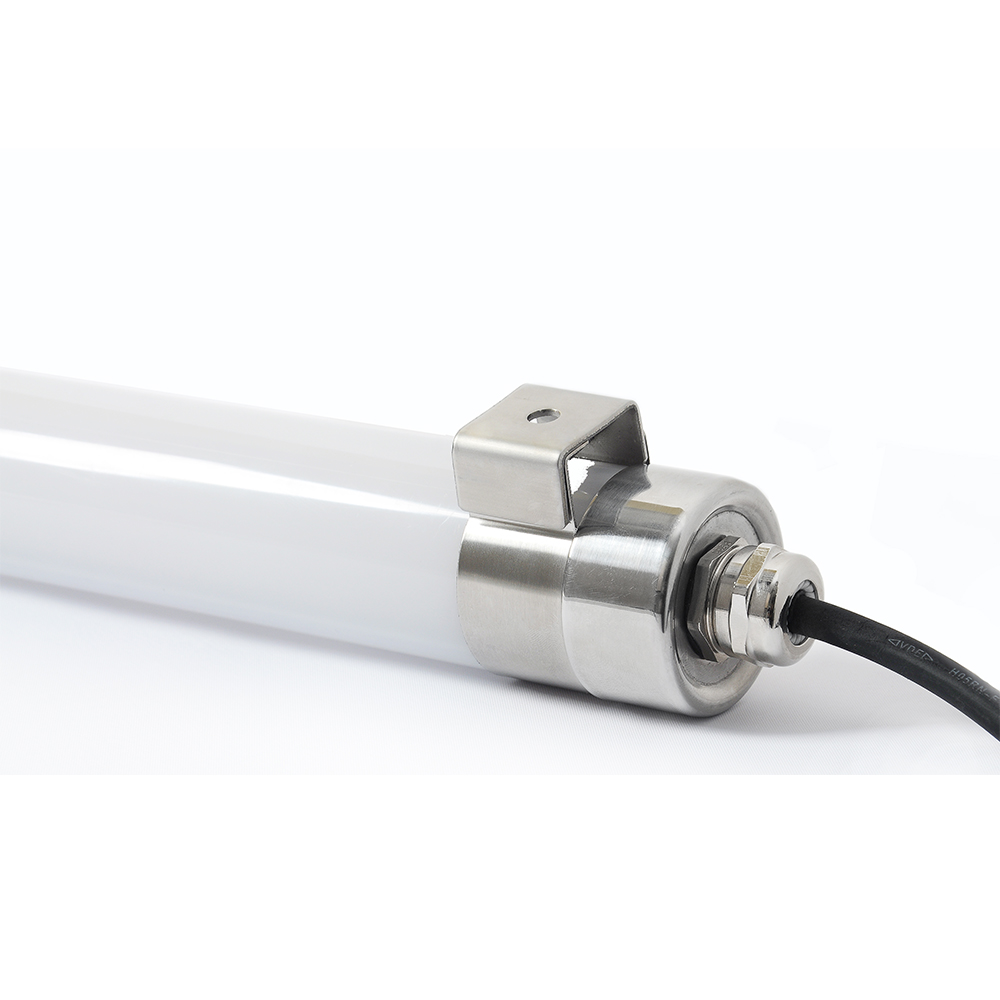
LED tubular light fixtures hold, and link tubular LED light bulbs to the power source and the surface where they are mounted. They are vital for ensuring the light system is installed and working correctly.
Fixtures also have numerous features that improve the performance and appearance of LED tubular light bulbs, including:
- Appealing Design: LED light fixtures adds a stylish, contemporary feel to LED tubular light bulb to match any space and theme.
- Durable: These types of light fixtures are sturdy and light in weight structure, which makes them highly resistant to harsh conditions and impacts within the factory or warehouse.
- Quality: These fixtures are equipped with high-quality, dependable electrical wiring that provides a safe and stable connection to LED tubular lights.
- Flexible Design: These fixtures feature an adjustable and flexible mounting system that lets you position and angle the LED tubular light bulbs according to your needs and preferences.
Types of Tubular LED Lighting Fixtures:
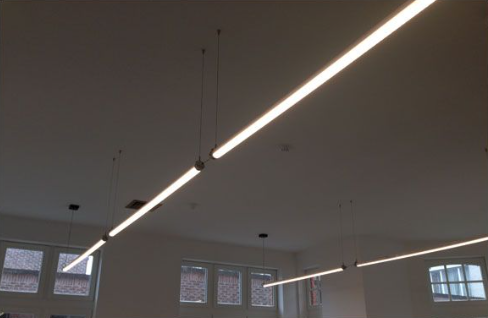
● Ceiling-mounted LED tubular light fixtures are the most common type of LED tubular light fixtures. They are attached to the ceiling or the roof of the room. They are ideal for spaces with high ceilings or large areas with ample illumination, such as commercial and industrial settings.
● Wall-mounted LED tubular light fixtures are a type that is attached to the walls or the pillars of the warehouse or factory. They are ideal for rooms with low ceilings or narrow areas that need focused illumination, such as highlighting artwork, signs, and other decorative elements.
● Pendant-mounted LED tubular light fixtures are suspended from the ceiling or the roof by cords or chains. They are ideal for rooms with medium ceilings or small areas needing decorative illumination or for use in areas requiring concentrated or task lighting.
Selecting LED Tubular Lights for Your Factory and Warehouse
There are many factors to ponder when upgrading your factory or warehouse lighting to LED tubular lights, such as:
● The size and layout of your space:
Measure the dimensions and shape of your factory, warehouse, or other space, as well as the location and height of the ceiling, walls, fixtures, and products.
This will help to determine how many LED tubular lights you need, how long and wide they should be, and how to arrange them to achieve optimal illumination and coverage.
● The type and quantity of products you store or produce:
Ponder upon the nature and characteristics of the products your manufacture or store, such as their color, texture, shape, size, and quantity. This will help determine the level and color of light you need and the angle and direction of the LED tubular lights.
For example, you may need lower and cooler light levels if you store or produce products sensitive to heat or light, such as food or pharmaceuticals.
Higher and warmer light levels are required to store or manufacture colorful or shiny products, such as clothing or jewelry.
● The level and color of illumination needed:
Depending on the tasks and preferences, you must ponder the amount and quality of light needed for your space in a factory or warehouse.
This will help determine your LED tubular lights’ wattage and color temperature.
For example, if bright and clear light is needed for detailed work or inspection, you may need higher wattage and cooler color temperature.
Lower wattage and warmer color temperatures are preferred when soft and cozy light for general work or relaxation is needed.
● The energy consumption and maintenance costs of your lighting system:
Ponder upon the impact of your lighting system on your electricity bills and maintenance expenses. This will help in determining the LED tubular light’s efficiency and durability.
For example, if you want to save money on energy consumption and reduce the carbon footprint, you may need tubular led lights that have a high luminous efficacy (the amount of light produced per unit of power consumed) and a low power factor (the ratio of real power to apparent power).
If you want to save money on maintenance costs and avoid frequent replacement, you may need tubular LED lights that have a long lifespan (the number of hours the light can operate before losing 30% of its brightness) and high resistance (the ability to withstand shock, vibration, dust, moisture, and extreme temperatures).
Tips for Proper Installation and Placement of LED Tubular Lights
- Reliable LED lights come with a user manual.
You must thoroughly read and follow its guidelines, instructions, and safety precautions when installing and connecting LED tubular lights.
Wearing protective gear and using the appropriate equipment and tools is vital. If you are not experienced or trained in electrical work, hire a professional electrician to do the job.
● Choose the correct type of LED tubular light fixture for your space and the LED tubular light bulb. Ensure the fixture matches your LED tubular light bulb’s size, shape, wattage, and color temperature.
Also, ensure the fixture is compatible with the power source and the mounting surface.
● Use the proper screws, bolts, brackets, or clips to securely and firmly mount an LED tubular light fixture to your ceiling, wall, or fixture.
Avoid using nails, glue, tape, or magnets, as they may not hold the LED tubular light fixtures in place or damage the surface.
● Position and angle the LED tubular light bulb according to your needs and preferences.
Adjust the LED tubular light bulb’s height, direction, and tilt to achieve optimal illumination and coverage for the factory or warehouse.
Besides, avoid placing light bulbs too close or too far from the products or tasks, as this may cause dotting, glare, or shadows.
Also, avoid placing LED tubular light bulbs near heat sources or flammable materials, which may affect their performance and lifespan.
● Test and check your LED tubular light system before using it. Turn on the LED tubular light system and observe its operation and output.
Ensure no flickering, dimming, buzzing, or overheating issues. If there are any problems, troubleshoot them or contact the bulb’s manufacturer or supplier for assistance.
Tips for proper maintenance and upkeep
To extend the lifespan and performance of your LED tubular light system, ensure its proper maintenance and upkeep.
Here are some tips for proper tubular LED light maintenance and upkeep:
● Clean the lights regularly to remove accumulated dust, dirt, and debris. Use a soft cloth or a vacuum cleaner to wipe or suck the surface of LED tubular lights gently. Avoid water, soap, or harsh chemicals which may damage the light bulbs.
● Inspect light bulbs periodically to check for any signs of wear and tear, such as cracks, chips, loose connections, or burned-out bulbs. If you find any problems, replace or repair the Led tubular lights immediately. Contact the manufacturer or supplier for assistance if needed.
● Monitor the LED tubular light bulb’s performance and output to ensure they work correctly and efficiently. Measure the lights’ brightness, color, and temperature using a light meter or a thermometer. Compare the results with the specifications of your lights. Adjust or replace the lights accordingly if you notice any deviations or fluctuations.
● Follow the light manufacturer’s guidelines and recommendations for the optimal use and operation of led tubular lights.
Avoid overloading, overheating, or dimming the LED lights beyond their capacity.
Also, avoid exposing the tubular lights to extreme conditions, such as high humidity, low temperature, or direct sunlight.
Conclusion,
LED tubular lights and fixtures are excellent for factory and warehouse lighting. They offer many benefits regarding energy efficiency, durability, quality, and versatility.
However, selecting LED tubular lights for your factory or warehouse is a complex task.
It requires careful planning and research. But don’t worry. Olamled is here to help. Our team of experts can guide you through choosing the best LED tubular lights for your space.
We will analyze your space and requirements, recommend the best LED tubular light products and fixtures, install them properly, and maintain them regularly. Exceptional customer service and assistance will also be extended to you.
Contact us today. We will be happy to answer your valuable questions or inquiries.
